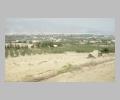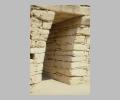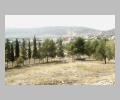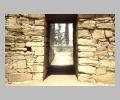| Summary: | Defining site for Thessalian Late Neolithic cultural phase. |
| Type: | Settlement |
| Region: | Magnesia |
Periods:
Neolithic
Physical:
Ca. 4 km W of Volos on a low mound, Dimini was discovered when archaeologists were excavating a Mycenaean tholos tomb built into the mound. One megaron-type building in an oval courtyard and sheds or shelters built inside against the yard's wall are enclosed by a series of 6 or 7 fortification ring-walls. Traces of smaller buildings or houses have been found outside the fortifications at the base of the mound.
Description:
The site of Dimini covers an area of ca. 5000 sq. m and flourished during the Thessalian Late Neolithic period (ca. 4000 - 3000 B.C.). The earlier Neolithic period is represented at Dimini by only a handful of sherds and the post Neolithic remains consists of a few cist graves of Middle Bronze Age date and the Late Bronze Age tholos tomb.
The architecture of the 2nd phase at Dimini shows the same construction methods and same use of materials as seen at earlier Sesklo. Dimini, however, has a definite fortification system in the form of 6 or 7 concentric circuit walls. Some of these walls were as close together as 1 m and may have been rubble filled double-faced fortress walls. The original number of walls is unknown. They vary in thickness from 0.6 to 1.4 m, were possibly 2 to 3 m in height, and were made of rough stone set in mud. The walls follow the natural contours of the hill and have no corners or towers. At the center and highest part of the oval shaped hill there was an oval courtyard in which a megaron type building and a few smaller buildings stood. Possibly one additional megaron and several additional structures were scattered within the walls.
Exploration:
Excavations: 1901, V. Stais; 1903, C. Tsountas.
Sources Used:
Other Bibliography:





